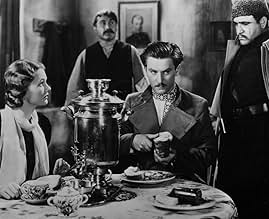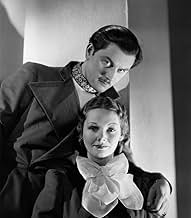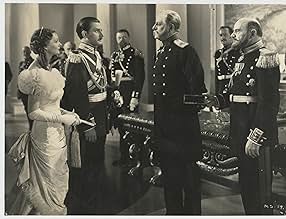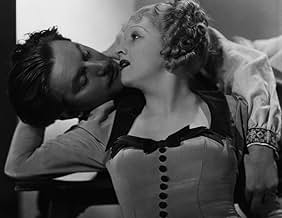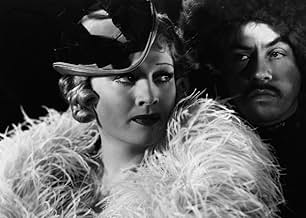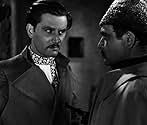Agrega una trama en tu idiomaA Russian courier struggles to deliver a message to the troops fighting Tartar invaders.A Russian courier struggles to deliver a message to the troops fighting Tartar invaders.A Russian courier struggles to deliver a message to the troops fighting Tartar invaders.
- Dirección
- Guionistas
- Elenco
- Premios
- 1 premio ganado en total
Oscar Apfel
- Tsar's General
- (sin créditos)
Margaret Armstrong
- Gypsy Woman
- (sin créditos)
Matthew Betz
- Chieftain
- (sin créditos)
Ward Bond
- Tartar Guard
- (sin créditos)
Lynton Brent
- Sailor
- (sin créditos)
Leonard Ceeley
- Tsar's Aide
- (sin créditos)
Harry Cording
- Peasant
- (sin créditos)
Opiniones destacadas
Blending footage perfectly from the French version that also starred Anton Walbrook, RKO Studios which normally did not have the budget to do a film from the ground up put out its own version of Jules Verne's Michael Strogoff with the same star.
Walbrook who after he left Hollywood in this his one and only film shot in America makes an impressive and intrepid courier of the czar. The Empire of Alexander II is being threatened by a revolt among the Tartars who are mistakenly identified as Moslems. In their leadership is Akim Tamiroff a former Russian army officer cashiered in disgrace. He's looking for payback.
Tamiroff learns of Strogoff's mission and has his own Mata Hari Margot Grahame on Walbrook almost immediately. That's in a figurative sense in the future she'd get the James Bond treatment. There's also a good girl in the mix with Elizabeth Allan and soon enough both of them are under his charm.
Comic relief is supplied in the culture clash war correspondents Eric Blore of the London Times and Edward Brophy of the Cleveland Chronicle. And Fay Bainter plays Strogoff's tragic mother. Why tragic and how she fits into the story is for you to see the film.
The American version is fine. It might have been better if one of the bigger outfits like MGM, 20th Century Fox, Warner Brothers, or Paramount had done the film. But this will whet your appetite to see the original French version. Years ago I saw a 1956 color version with Curt Jurgens in the title role, but it seems to have disappeared.
This one will do nicely though.
Walbrook who after he left Hollywood in this his one and only film shot in America makes an impressive and intrepid courier of the czar. The Empire of Alexander II is being threatened by a revolt among the Tartars who are mistakenly identified as Moslems. In their leadership is Akim Tamiroff a former Russian army officer cashiered in disgrace. He's looking for payback.
Tamiroff learns of Strogoff's mission and has his own Mata Hari Margot Grahame on Walbrook almost immediately. That's in a figurative sense in the future she'd get the James Bond treatment. There's also a good girl in the mix with Elizabeth Allan and soon enough both of them are under his charm.
Comic relief is supplied in the culture clash war correspondents Eric Blore of the London Times and Edward Brophy of the Cleveland Chronicle. And Fay Bainter plays Strogoff's tragic mother. Why tragic and how she fits into the story is for you to see the film.
The American version is fine. It might have been better if one of the bigger outfits like MGM, 20th Century Fox, Warner Brothers, or Paramount had done the film. But this will whet your appetite to see the original French version. Years ago I saw a 1956 color version with Curt Jurgens in the title role, but it seems to have disappeared.
This one will do nicely though.
THE ADVENTURES OF MICHAEL STROGOFF (aka THE SOLDIER AND THE LADY) is a strange little movie. At first glance it's an American production, but then it turns out to be a version of a French version of a German movie. Confused yet? In essence, lots of footage is taken from the European original(s) with some added-in sub-plots involving a couple of comic relief characters commentating on the action.
The film is a fairly typical swashbuckler for the era, ostensibly based on a Jules Verne story. The fact that it involves the Russian Empire makes for a refreshing change, but otherwise it's business as usual. The bad guys are dastardly and of the moustache-twirling variety while the hero is put through the mill during the course of the production.
There are certainly some rousing bits of spectacle along the way, including well-filmed horse and carriage chases. The ending is inevitably stirring, with a nice twist. Strogoff gets the chance to indulge in some fisticuffs with a bear and is later subjected to a torture scene straight out of a FU MANCHU movie. It's all heavily dated so only those with a nostalgic eye for the era will likely enjoy it.
The film is a fairly typical swashbuckler for the era, ostensibly based on a Jules Verne story. The fact that it involves the Russian Empire makes for a refreshing change, but otherwise it's business as usual. The bad guys are dastardly and of the moustache-twirling variety while the hero is put through the mill during the course of the production.
There are certainly some rousing bits of spectacle along the way, including well-filmed horse and carriage chases. The ending is inevitably stirring, with a nice twist. Strogoff gets the chance to indulge in some fisticuffs with a bear and is later subjected to a torture scene straight out of a FU MANCHU movie. It's all heavily dated so only those with a nostalgic eye for the era will likely enjoy it.
I'm giving 6 to this film, well below it's current ranking at IMDb, and just for the powerful scenes that remain in it, from the original French production "Michel Strogoff" aka "Der Kurier des Zaren" (1936), by German director Richard Eichberg. The introduction of two comic-relief characters speaks a lot of the lack of culture, ethics, and common-sense of the American producers who concocted this version, re-issued under a different title yet, in 1945, in which Akim Tamiroff was given first credits - to bank on his 1940 public acknowledgement in "The Way of All Flesh". Speaking of flesh, Michel Strogoff is whip-tortured by Ogareff in front of his mother, and girl friend: first you see his naked torso (from the Franco-German film), and then you see him in tattered shirt (from the American added footage)... As if the Russian outlaws would decide to cover the man's torso after the first set of whip-lashes! Since the earlier film is impossible to view these days, I guess we must put up with this version to have glimpses of the former greatness of battles, horse charges, and human emotions - like that silent suffering mother. A pity Eichberg is not credited for the only good footage in this film.
I saw this wonderful film when I was 15 in 1940, a local cinema in Barcelona and still love very much as well as the nostalgia that surrounds those days of black and white film that we like so much. talking about the film in its technical, special effects and perfect interpretation; all area perfect. "I don't know why they are doing chariot races - is nothing these races they made already in the Roman Empire" - commentary between the two journalists in the carriage - the interpretation of Anton Walbrook is memorable, as well as the rest of actors and actresses. scenarios are beautiful even in black and white, great staging of the thousands of extras and the Russian cavalry and tartar. Anton Walbrook in the role of Michael Strogoff is great, as well as Akim Tamiroff in the role of Ogareff, Fay Bainter is exquisite and sweet as the hero's mother, Elizabeth Allan as the girlfriend of Michel Strogoff is so beautiful and sweet as the heroines of those times, finally a great movie that I never tire of seeing and seeing.
Tsarist courier Michael Strogoff has an important message to deliver to Grand Duke Vladimir. Rebel leader Ivan Ogareff is rampaging in Siberia. Strogoff falls for Nadia. He picks up two comedic reporters and survives Tartar revolt along the way.
There seems to be different versions and this one has been edited from an earlier one. I can't really tell and I don't have the ability to compare any of them. It's a fine action adventure thriller. There is some good action, some really big action. This could be more personal. The big action do take over in the second half.
There seems to be different versions and this one has been edited from an earlier one. I can't really tell and I don't have the ability to compare any of them. It's a fine action adventure thriller. There is some good action, some really big action. This could be more personal. The big action do take over in the second half.
¿Sabías que…?
- TriviaRKO bought the rights to the French version Michel Strogoff (1936) for $75,000, and specifically signed its star Anton Walbrook so that they could use some scenes from that movie. About 22 scenes were edited into the new version, including Siberia footage, battle footage, Tartar camps and the river on fire. The Hollywood Reporter mentioned that the new footage shot blended perfectly with the old footage.
- ErroresWhen Strogoff is being chased on horseback from Omsk, the horse trips in an open area well within view of those chasing him. Yet just after he falls, he is suddenly in a wooded area and he is able to hide himself as his chasers just ride on past.
- Citas
Cart Driver: I take your money, you take a walk.
Henry Blount: I say, but that's most frightfully one sided.
- Créditos curiososOpening credits: 1870 During the reign of Tsar Alexander II, the fate of the Russian Empire was threatened by a great Tartar uprising in Siberia ......
- ConexionesEdited from Der Kurier des Zaren (1936)
- Bandas sonorasGod Save the Tsar
(1833) (uncredited)
(Russian national anthem, 1833-1917)
Music by Alexis Lvov
Variations often in the score
Selecciones populares
Inicia sesión para calificar y agrega a la lista de videos para obtener recomendaciones personalizadas
Detalles
- Fecha de lanzamiento
- País de origen
- Idioma
- También se conoce como
- Michael Strogoff
- Locaciones de filmación
- Productora
- Ver más créditos de la compañía en IMDbPro
Taquilla
- Presupuesto
- USD 400,000 (estimado)
- Tiempo de ejecución1 hora 25 minutos
- Color
- Relación de aspecto
- 1.37 : 1
Contribuir a esta página
Sugiere una edición o agrega el contenido que falta

Principales brechas de datos
By what name was The Soldier and the Lady (1937) officially released in Canada in English?
Responda

